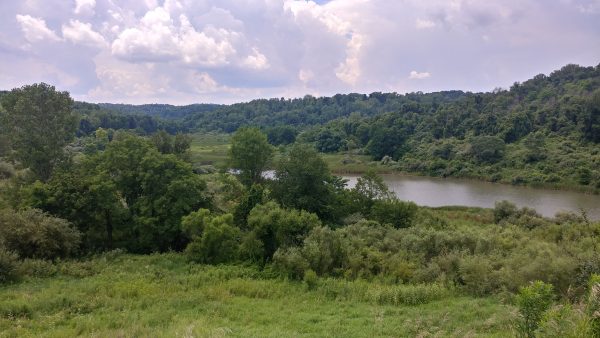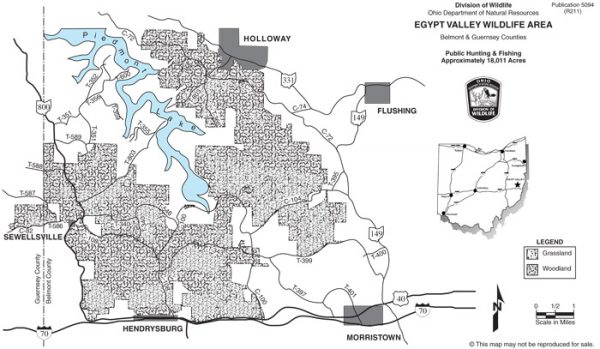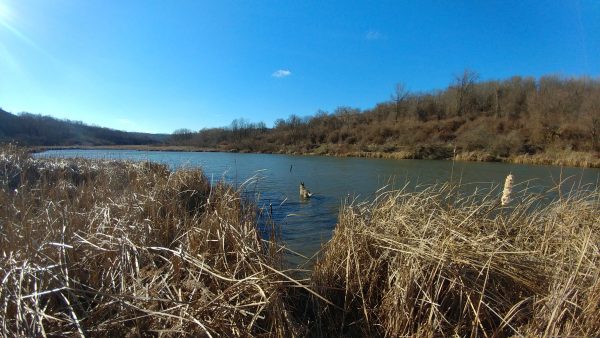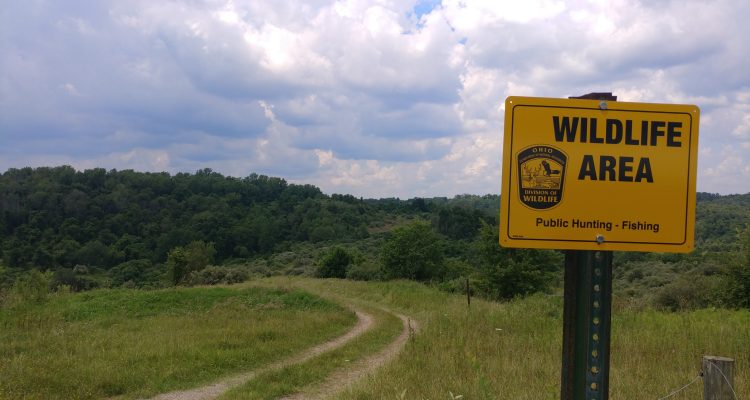I just got back from a Yellowstone vacation. In addition to the mountain-gazing, geysers, and grizzly bears, I was particularly taken with the wide-open landscapes. Wildlife roamed the green valleys, and strips of blue water meandered through the rolling hills. What a shame, I thought at the time, that I can’t see this sort of view at home.
Here in our corner of the world, we don’t see many open valleys. It just isn’t in the topography. Our hills are steep and tight, our gorges deep and narrow. They’re quite lovely, but when I’m yearning for the open spaces of the west, there is indeed a place I can visit that feels strikingly similar: Egypt Valley Wildlife Area.
You’ve seen Egypt Valley every time you’ve driven west on I-70 past Morristown. Its 14,300 acres sit in both Belmont and Guernsey counties and abut Piedmont Lake. Grass and scrub cover much of the open space; pockets of hardwood forest offer shade and seclusion. Ponds and wetlands lay in the valleys. Most of the roads are roughly paved or dirt.
At present, gas drilling is happening in certain places, but the history of resource extraction goes back 70 years. Eighty percent of Egypt Valley Wildlife Area has been surface mined, most notably by the GEM (“giant earth mover”) of Egypt, a giant power-shovel and sister to the famous Silver Spade. YouTube videos depict the GEM working in the valley years ago. The land you see today was barely recognizable during the height of the GEM’s activity. Thankfully, reclamation laws ensured that the area had a future as a wildlife area.
When mining finished in the mid-1990’s, the Ohio DNR took over the administration of the area. Despite the scouring it received, nature came back the land. Slowly, second- and third-generation forests grew up in many places, but much of the area is open grassland, dotted with shrubs. You’ll find ponds here and there, and some have graduated to small lakes with the help of nature’s engineers, beavers. Their presence indicates a healthy ecosystem, and their efforts produce a positive ripple effect on other systems such as water quality and biodiversity. Otters introduced in the 1990’s have done well as the other aquatic, mammalian residents of Egypt Valley.

It’s public land, which means that it’s available to anyone who wants to use it. Lunkers lurk in the ponds. Some fishing spots require a bit of a hike, but the bass are there, my friends, thanks to the efforts of the DNR, who also stock catfish and bluegill. Beneath the few remaining highwalls, the ponds get deep.
I pass through Egypt Valley on the weekends when we visit Piedmont Lake. My parents can remember when the land was brown and bare in the 1970’s. To think how the valley has changed and been reborn astounds me. Today, bird-watchers can see the bald eagles and osprey that live on the lake, along with turkey, herons, waterfowl, and grouse. You may also spot unusual species like the short-eared owl, Henslow’s sparrow, the Northern Harrier, and bobolink. (It’s a tiny blackbird. I had to look it up.)
If you’d rather hunt for them than spot them, that’s cool too. Egypt Valley is open. Pick your season. Pick your critter. Hunters frequent the area with regularity, and I often see them returning to their trucks with heavy loads and high spirits (so if you’re camping, try not to dress like an eight-point buck). ODNR’s website provides helpful information on hunting seasons.
I’m not a hunter, and though I fish, I love Eygpt Valley for the hiking. In particular, it serves as a wonderful spot for a walk in the fall, when the weeds and brambles have died, and in the spring, when the land is coming back to life with bits of new, yellow-green growth. You’ll find a few paths and rough roads, but the open terrain allows hikers to go where they please. It’s one of the few places where I take my dogs off the leash and let them run free as wild, dirty beasts. They come home stinky and covered in burs and we all need a good hosing, but what a place to be a dog.*
As an aside: Cattle farmers lease some of the lands for grazing. Buy me a local beer sometime and I’ll tell you about the afternoon my Doberman pinscher captured a confused Hereford of her very own.

If hiking isn’t quite your thing, Egypt Valley offers something for the brave at heart. Not only will you find Salem Cemetery with its mossy, crumbling gravestones from two centuries past, but you’ll also find its residents wandering about in the moonlight. Though a variety of paranormal activity has supposedly been detected in the area, the most well-known story recalls Thomas Carr, who murdered his 13-year-old ex-fianceé, Louiza Fox in 1869. He became the first murderer to be hanged in Belmont County—on the courthouse steps, in fact—and he and his victim allegedly haunt the hills and valleys of Egypt. Her ghost is often seen wandering the cemetery, crying, or a mile up the road near the stone that marks the site of her murder. Ghost hunting groups sometimes tour the valley in search of paranormal findings.
Bigfoot, too, was spotted in 1984. However, the Egypt Valley Sasquatch is said to be a slow runner and rather clumsy, so a reliable pair of Adidas should get you back to your car with plenty of time to spare.
My heart smiles when I see people using the land in Egypt Valley. In all seasons I see them out there, for what good is public land if it goes unappreciated? I took my family for a hike the day after Christmas last winter. We walked along a ridge and down to two beaver dams. A family of crows nearby called to each other. My boys fell down a hill and found a beaver stick. The sun that day hung low in the sky, but it was bright and the world quieted under the expansive blue.

In 1970, the New York Times published an article titled “Strip-Mining Boom Leaves Wasteland in Its Wake,” about the operation in Egypt Valley and the toll it took on the land and its residents in exchange for the extraction of resources.
“They’re turning this beautiful place into a desert,” one Belmont County representative was quoted as saying. “No one has figured out what will happen to us here when they’re through, but I can tell you it isn’t going to be pretty.” Officials doubted the land would ever support more than a rabbit population when the big machines had moved on. And while a spokesman for the coal industry argued for the value of the strip mine, he acknowledged that reclamation would require 30 or 40 years.
Thirty or forty years later, reclamation efforts have been successful. Egypt Valley is beautiful. Coyotes dash through the bushes and red-tailed hawks look down on hikers, fishermen, and hunters. I saw a long-tailed weasel last spring, darting across the road, and an Indigo Bunting—the most stunning of blue birds—just a few weeks ago. Nature has reclaimed Egypt in her own time, in her own way, with a lot of help from the state of Ohio. The desert did not endure. Life came back to the valley.
I hope you will go out there and see it for yourself.
*Use caution when walking dogs during hunting season. Coyotes and skunks also live in Egypt Valley. The author is not responsible for your skunkified dog.




